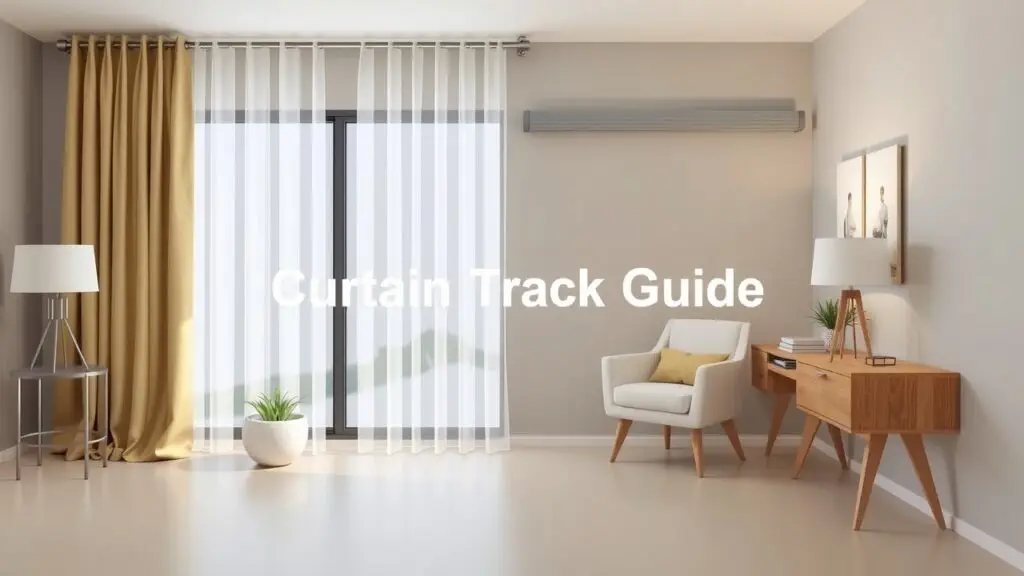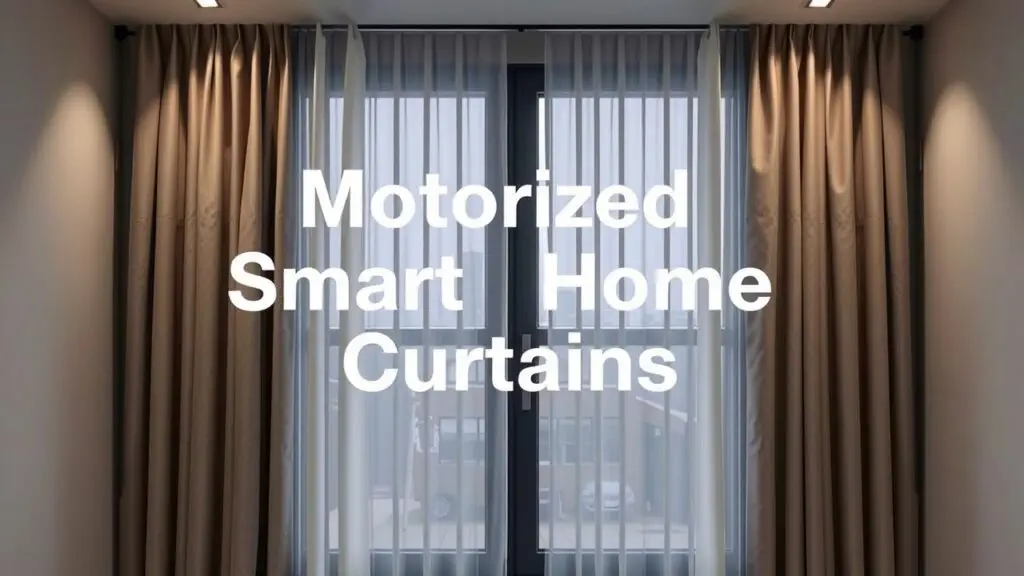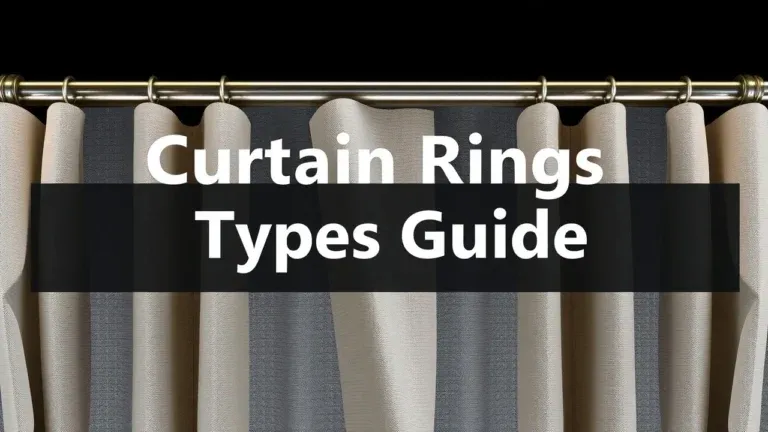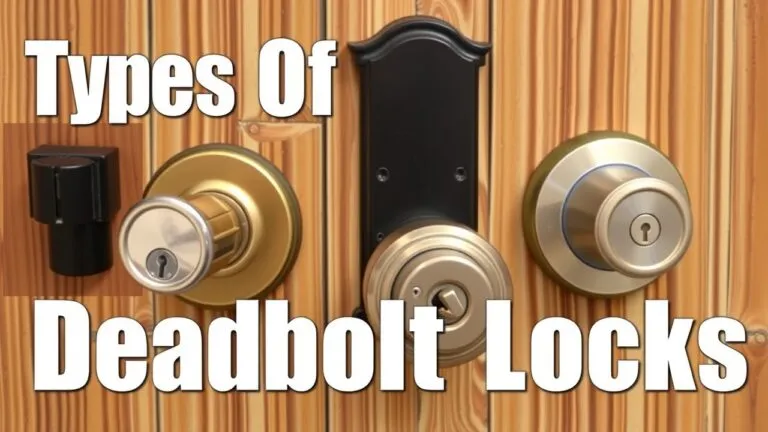Types of curtain tracks vary widely; this guide covers different systems, including track carriers and glides, plus easy-to-follow installation instructions. Learn about different options and find the perfect fit for your home.
What Are Curtain Tracks?

Curtain tracks are systems that help hang and operate curtains easily. They are different from traditional rods because they offer more movement. You can mount them on walls or ceilings, and they come in many styles. Here are some common types of curtain tracks:
- Wall Mount Curtain Tracks: These attach directly to the wall for a neat look. They make it easy to reach your curtains.
- Ceiling Mount Curtain Tracks: Great for rooms with high ceilings, these tracks create a smooth, seamless appearance.
- Standard Curtain Tracks: Made from lightweight materials, these work best for lighter curtains.
- Traverse Rod Curtain Tracks: Perfect for heavy drapes, these use cords to pull curtains open or shut.
- Decorative Curtain Tracks: These combine style and function, often featuring nice designs that improve room decor.
The key difference between curtain tracks and traditional rods is how they work. Rods use rings or hooks to hold the curtains in place. In contrast, curtain tracks have gliders that move within the track. This setup makes it easier to open and close even heavy curtains.
Why Choosing the Right Curtain Track Matters?
Picking the right curtain track is really important. It affects how well your curtains work in your space. Here are some reasons why:
- Impact on Operation: The type of track you choose changes how easily you can move your curtains. Heavy-duty tracks support bigger drapes but might need more effort to operate than light-duty options.
- Aesthetic Considerations: Different styles of curtain tracks can match your room’s design. Decorative options can add beauty while still being useful.
- Durability Factors: The material affects how long the track lasts; metal tracks usually last longer than plastic ones but might be heavier.
- Room Efficiency (Light Control and Insulation): Good installation of curtain tracks helps with energy savings by improving insulation when you pair them with room darkening curtains.
Understanding various types of curtain tracks helps homeowners make smart choices for their spaces, whether they need support for heavy fabrics or want to enhance their home’s look.
Types of Curtain Tracks Explained
Standard Curtain Tracks
What They Are & Best Uses
Standard curtain tracks are simple systems made of plastic or metal. These tracks can hold light to medium weight curtains. You can mount them on walls or ceilings. This makes them a good choice for many rooms. They are easy to install, which is great for homeowners who want a quick setup.
Pros/Cons:
One big plus of standard curtain tracks is their price—they’re budget-friendly! But, they might not have as many design options as some other types. If you’re looking for a specific style, this could be a downside.
Glider Tracks
Features & Benefits
Glider tracks have smooth carriers called gliders. These help heavier curtains move easily. They work best for larger windows where you want curtains to slide smoothly. The strong build makes them last long, so they’re good for homes and businesses that use heavy drapes.
Pros/Cons:
Glider tracks are durable and flexible, but they usually cost more than standard ones. Many users like how well they support medium-weight curtains, but think about the installation needs depending on your window size.
Curved/Flexible Curtain Tracks
Ideal for Bay Windows & Arched Designs
Curved or flexible curtain tracks can bend around unique shapes like bay windows or arched doors. This allows you to create custom designs that fit your space perfectly.
Pros/Cons:
The main benefit is how nice they look in any room! Still, because they’re a bit tricky to install, you might need a professional to help out with measuring and fitting.
Cordless Systems
Safety-Focused Design
Cordless systems are a safe choice because they don’t have hanging cords. Instead, they use wands or pull mechanisms. This means there’s less risk for kids and pets around your home.
These systems keep your living space neat while giving you full control over opening and closing your curtains easily. They work great in family homes!
Material Considerations & Weight Capacity
Material Options
When you pick curtain tracks, the material matters a lot for both how they work and how they look. Here are some common choices:
- Aluminum Curtain Tracks: These tracks are lightweight and strong. They don’t rust or corrode, making them great for modern or traditional styles.
- Plastic Curtain Tracks: These are cheap and light, but they might not hold up with heavy curtains. They work best for lighter fabrics or sheer panels.
- Wood Curtain Tracks: Wood gives a warm look that fits classic rooms. However, they need more care to stop warping.
- Vinyl Curtain Tracks: This is a low-cost option that’s easy to clean, but vinyl can’t support much weight compared to other materials.
Comparing Durability and Aesthetic Appeal
Durability often goes hand-in-hand with how nice something looks when choosing curtain track materials.
Aluminum is strong and looks good in modern settings because of its shiny finish. Meanwhile, wood brings warmth and charm to traditional spaces but requires regular care.
Plastic is budget-friendly and handy for light use, like sheers or light curtains, yet it doesn’t last as long as metal or wood options. On the flip side, some eco-friendly options made from recycled materials offer smart choices without losing style—some brands focus on being sustainable.
Weight Capacity
Knowing weight capacity is key when choosing curtain tracks since different types can hold different amounts based on their material.
Detailed Discussion on Weight Capacity by Track Type
Regular curtain tracks usually handle moderate weights well; however:
- Glider Systems: These are built for heavier drapes due to better roller mechanisms.
- Motorized Systems: These systems often provide convenience but vary in strength based on design specs.
Each type’s weight limit depends a lot on the materials used; aluminum holds heavy loads well while plastic works for lighter fabrics.
| Material | Weight Capacity | Best Use Cases |
|---|---|---|
| Aluminum | Up to 50 lbs | Heavy drapes |
| Plastic | Up to 15 lbs | Light curtains |
| Wood | Up to 30 lbs | Classic interiors |
| Metal | Varies (upwards of 40 lbs) | Versatile applications |
Importance of Matching Track Capacity to Curtain Weight
Choosing a track that matches your curtain’s weight is really important. If the track can’t support the fabric’s weight—whether it’s due to stress during use or breaking—it could lead to damaged curtains. More seriously, it can cause hardware to fall or create hazards in your space. So, always check that your chosen system fits the specific needs of your window treatments before putting it up.
Installation Guide & Troubleshooting
Installation Guide
Installing curtain tracks can make your home look better and work better too. You can choose to install DIY curtain tracks yourself or hire a pro. Either way, you need to measure your window size right for a good fit. Tools you’ll need include a tape measure, level, drill, and screwdriver.
Step-by-Step Instructions
When installing wall mount or ceiling mount curtain tracks, here’s what to do:
- Measure Your Window: Check the width and height where the track will go.
- Select Hardware: Pick between heavy-duty or light-duty curtain tracks based on how heavy your curtains are.
- Mark Mounting Points: Use a pencil to mark where you’ll put brackets on the wall or ceiling.
- Drill Holes: Drill at the marked spots using the right drill bit.
- Attach Brackets: Securely fasten brackets with screws that come in your hardware kit.
- Install Track: Slide the track into place over the mounted brackets.
Make sure everything is tight before hanging your curtains.
Tips for Measuring
Good measurements are key for great-looking curtains. Always measure twice before cutting anything or buying hardware to avoid mistakes.
Using Appropriate Hardware
There are different bracket systems based on whether you’re mounting on walls or ceilings and the type of track used (standard vs heavy-duty). Make sure to choose brackets that match your curtain track system so they hold up well.
Troubleshooting Common Issues
Some common problems include sagging tracks if brackets aren’t strong enough, noisy operation from dirty gliders, or sticking gliders that make it hard to open and close curtains.
Common Problems & Solutions
If your curtain tracks sag, check if all brackets are tightened; adjusting their position might help fix it. For broken gliders, replacing them usually works—many manufacturers have replacement parts online.
To fix noise during operation:
- Clean gliders with mild soap and water,
- Lightly spray silicone lubricant along the track if needed.
Maintenance Tips Post-Installation
To keep your curtain system in good shape:
- Clean every few months
- Dust both curtains and tracks
- Check hardware for signs of wear
This will help everything work well without surprises down the line.
Choosing the Right Curtain Track: A Buyer’s Guide
Factors to Consider
When picking curtain tracks, there are some things you should think about. First off, check what type of window you have. For example, bay windows or sliding doors need different curtain track types to look good and work well. Next, consider the weight of your curtains. If you have heavy curtains, you’ll need strong tracks that won’t sag or bend under their weight.
Your budget is also a key point. You can find many curtain track options at various prices, from cheap plastic tracks to more durable metal systems made for heavy use. Installation can be different too; some tracks are easy to put up by yourself, while others might need a pro’s help.
Finally, think about the materials used in the curtain track. You can choose aluminum or steel for strong options or PVC if you want something lighter for lighter curtains.
Decision-Making Flowchart/Table
To help you pick the right type of curtain track for your needs, here’s a simple comparison table:
| Type of Curtain Track | Best For | Weight Capacity | Installation Difficulty |
|---|---|---|---|
| Standard Rods | Light to medium curtains | Up to 10 lbs | Easy |
| Ceiling Mounted Tracks | High ceilings & modern looks | Up to 20 lbs | Moderate |
| Bay Window Tracks | Angled windows | Up to 15 lbs | Moderate |
| Heavy-Duty Tracks | Heavy drapes | Over 20 lbs | Difficult |
This table makes it easier to see which type could fit your specific needs best.
Case Studies/Examples
Here are two examples where different types of curtain tracks shine:
- Bay Windows: If you have bay windows, custom-made bay window curtain tracks can make them look nice and allow the curtains to move along the curve smoothly.
- Large Bedroom Windows: For big bedroom windows that need good coverage and style, heavy-duty ceiling-mounted tracks work well. They provide both strength and beauty when paired with rich drapes.
These examples show how knowing your space helps you choose the right curtain tracks for your home improvement projects.
Motorized and Smart Home Integration

Motorized Curtain Tracks
Motorized curtain tracks are a great modern option for your windows. They provide convenience and easy use. These systems can be battery-operated or wired, so you can choose what fits your home best. You can control automated curtain tracks with remote controls or smartphone apps. This makes them perfect for those into smart home tech. Electric curtain tracks work really well in big spaces where it’s tough to pull curtains by hand.
Control Methods
You can control motorized curtains in different ways. One option is using a smartphone app, which lets you open or close curtains from anywhere in your house. Voice control is another cool feature, compatible with devices like Amazon Alexa and Google Assistant. Plus, you can use multi-channel remotes to manage several curtains at once.
Pros and Cons of Motorized Systems
Motorized systems come with big benefits. They offer great convenience, especially for hard-to-reach windows. You can set when curtains open or close to control your home lighting better. But there are some downsides too; sometimes the electric parts might have technical issues that could need fixing.
Ideal Use Cases for Motorization
These motorized solutions work best in certain situations. They are super helpful for large windows that would take a lot of effort to operate manually. They’re also ideal for high ceilings or hard-to-reach windows where pulling the cord is tricky.
Smart Home Compatibility
Integration with Smart Home Systems
A lot of motorized curtain tracks easily fit into your smart home setup. This means you can link them with other smart devices in your home for added convenience. Compatibility with systems like Alexa and Google Assistant allows you to use voice commands easily.
Automation Features Available
Automated scheduling is a handy feature that lets you set times for your curtains to open or close each day automatically. Some advanced models even track sunrise and sunset, so your space changes with the daylight naturally.
Energy Management through Automation
Using these automation features helps save energy at home by making the most of natural light throughout the day while keeping privacy during evenings without needing to do it yourself.
Maintenance and Cleaning
Taking care of your curtain tracks is key for keeping them working well. Regular maintenance can help avoid problems, so you can enjoy your curtains without any fuss.
Regular Maintenance Tips
To keep your curtain tracks in good shape, do these things every few months:
- Check for wear or damage, like bent tracks or loose brackets.
- Clean off any dust or dirt that collects on the tracks. This stops curtains from sticking.
- Use a silicone lubricant on gliders. This helps them move smoothly and quietly.
Cleaning Procedures
Cleaning your curtain tracks should be part of your regular routine:
- First, take down the curtains from the track.
- Use a damp cloth with mild soap to wipe down both metal and plastic parts.
- If there are tough stains, use a soft brush to scrub gently.
This keeps everything clean and helps prevent any issues caused by dirt buildup.
Troubleshooting Common Issues
If you notice problems like sagging curtain tracks or noisy operation, try these tips:
- Check if all brackets are tight; if not, tighten them.
- Look at the gliders; replace any that are broken to stop bigger problems.
These troubleshooting steps can help you fix small issues before they get worse.
Parts Replacement Guidance
When it’s time to replace worn-out parts:
- Figure out which pieces need replacing, like carriers or glides.
- Get new parts from trusted suppliers that specialize in curtain track accessories.
By following these maintenance and cleaning tips for your curtain track systems, you can help them last longer and work better every day.
Frequently Asked Questions About Curtain Tracks
What are the different types of curtain tracks available?
Curtain tracks come in several styles. Common types include wall-mounted, ceiling-mounted, motorized, and flexible tracks for curved windows.
How do I choose the right curtain track for my curtains?
Match the track to your curtain weight. Check the manufacturer’s specifications for weight limits. Consider your window style as well.
Can I install curtain tracks myself?
Yes, many tracks are designed for easy DIY installation. Follow the instructions closely for best results.
What materials are curtain tracks made from?
Tracks can be made from aluminum, plastic, wood, or vinyl. Each material has its advantages and weight capacities.
How do I maintain and clean my curtain tracks?
Clean regularly with a damp cloth. Check brackets and gliders for wear and lubricate when necessary.
What are the benefits of motorized curtain tracks?
Motorized tracks offer convenience and ease of use. They can be controlled remotely or through smart home devices.
Are there decorative options for curtain tracks?
Yes, decorative curtain tracks enhance room aesthetics while providing functionality.
What is the weight capacity of different curtain track types?
Weight capacity varies by type: standard tracks support lighter curtains while heavy-duty tracks manage much heavier drapes.
Where can I buy high-quality curtain tracks?
High-quality options are available at home improvement stores, specialty retailers, and online marketplaces.
Curtain Track Styles for Different Windows
- Suspended Ceiling Curtain Tracks: Ideal for modern spaces with high ceilings.
- Sloped Ceiling Curtain Tracks: Perfect for angled ceilings in attics or lofts.
- Bay Window Curtain Tracks: Custom shapes fit snugly into bay windows.
- Heavy-Duty Curtain Tracks: Designed to support thick drapes or heavy fabrics.
- Tension Curtain Rods: Great for small spaces without mounting hardware.
- Shower Curtain Tracks: Water-resistant options fit bathroom needs.
- Corner Curtain Tracks: Accommodate unique room layouts effectively.
- Double and Triple Track Systems: Allow layered curtains for enhanced privacy and light control.
- Smart Curtain Tracks: Integrate with smart home systems for automated control.
By focusing on these styles, you can find the right curtain track that meets your needs while enhancing your space’s look.
Related Topics
- Types of Curtain Track Materials
- Types of Curtain Track Installation Methods
- Types of Curtain Track Control Mechanisms (Manual vs. Motorized)
- Types of Curtain Track Weight Capacities
- Types of Smart Home Integrations with Curtain Tracks
- Types of Windows Suitable for Different Curtain Tracks
- Types of Curtain Track Maintenance Procedures
- Types of Curtain Track Cleaning Methods
- Types of Curtain Track Troubleshooting Solutions
- Types of Curtain Track Accessories



Types of Curtain Tracks: A Complete Guide to Systems, Installation & More